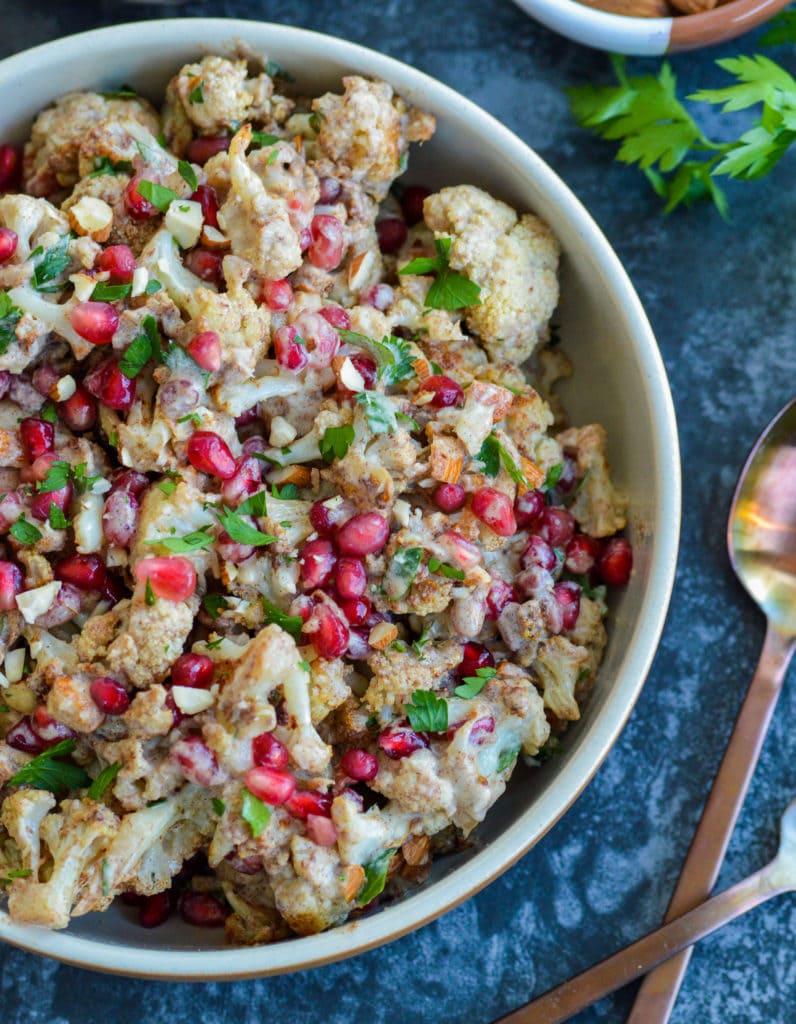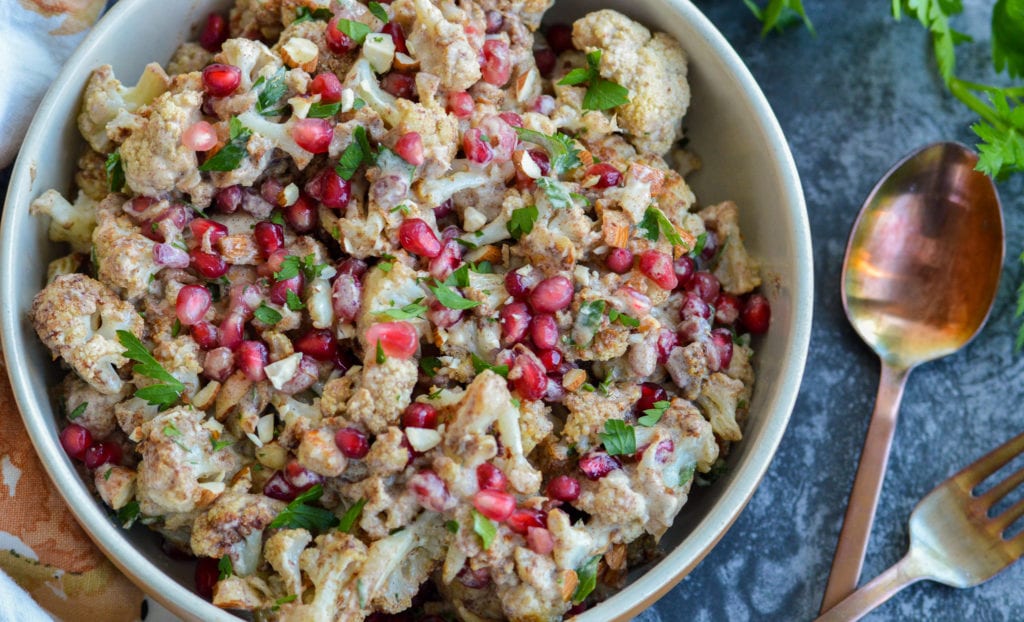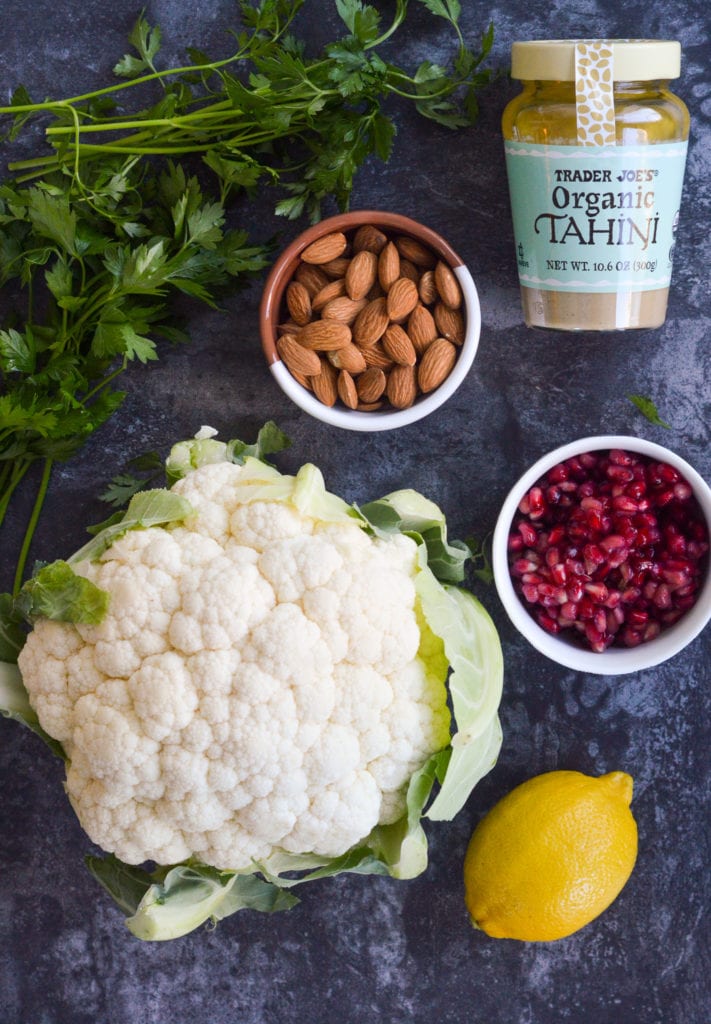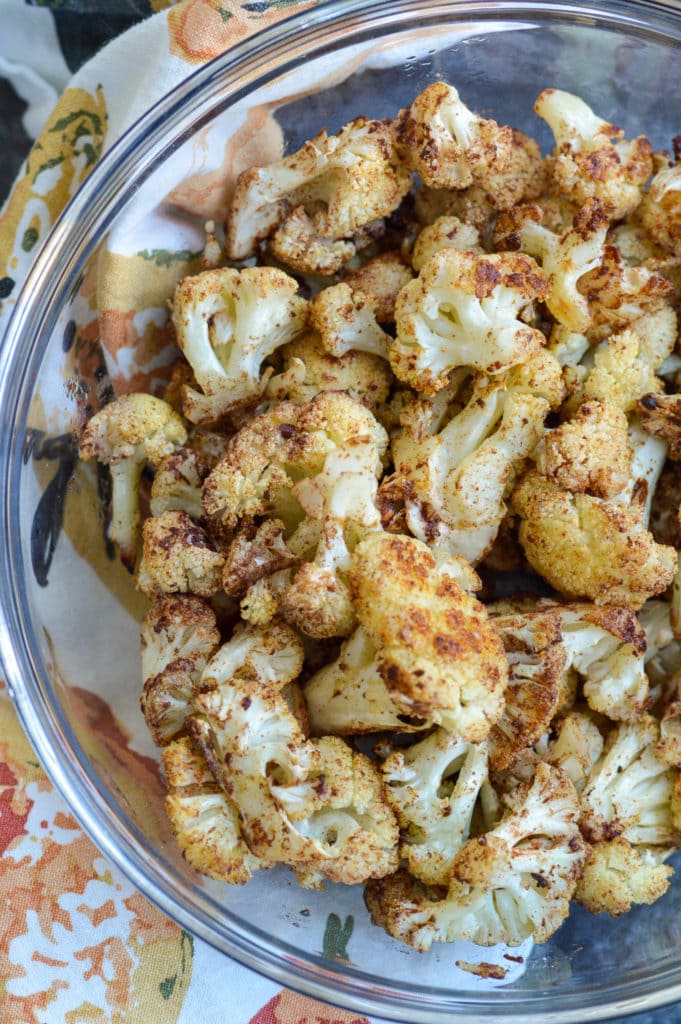Warm Roasted Cauliflower and Pomegranate Salad is a simple vegan side dish that you’ll crave all season long.
I can’t believe it is the time of the year for fall and winter produce. Where did the year go? I don’t have many recipes that include pomegranate arils, but I love these juicy vibrant seeds that add so much flavor and texture to a dish.
That’s why I am excited to introduce my Warm Roasted Cauliflower and Pomegranate Salad. The juicy tart flavor of the pomegranate seeds pairs perfectly with cauliflower, a creamy tahini dressing, crunchy roasted nuts and herbs. This is a flavor combination like no other, and it will definitely become one of your favorite easy vegan sides.

What are the health benefits of Pomegranates?
Let’s take a closer look inside the pomegranate. The peel of the fruit is inedible (and is usually turned into extracts), but the seeds and juice are ripe for consumption. Pomegranates are quite an intimidating fruit from the outside, but once you cut them open, you are rewarded with these gorgeous red jewels, called arils. Many people don’t realize that arils is a collective term for both the seeds and juice of the fruit.
So what exactly do pomegranates contain that make them so healthful? There are two main plant compounds that are responsible for most of their health benefits – punicalagins and punicic acid. Punicalagins are found in the juice and peel, while punicic acid is the main fatty acid present in the seeds.
Punicic acid has demonstrated antioxidant, anti-inflammatory and anti-carcinogenic properties. Inflammation in the body has been linked to increased susceptibility for disease, so it only makes sense that the anti-inflammatory properties of pomegranates are linked to a lower risk of heart disease, cancer, type 2 diabetes, Alzheimer’s disease and even obesity.

Pomegranate seeds are a nutrient-dense food, packed with Vitamin C, Vitamin K, Vitamin E, as well as phosphorus, zinc, magnesium, folic acid, calcium, and potassium. Half a cup of arils makes up 15% of the daily value of Vitamin C, and 18% of the daily value of Vitamin K. For athletes, the high vitamin C content is especially important as it supports the building of strong bones, cartilage and muscles. Vitamin C also increases iron absorption, a nutrient that is crucial for plant-based athletes.
What is Tahini?
Tahini is a plant-based paste that is made from ground sesame seeds. It is a condiment most commonly used in Middle Eastern culture and is often incorporated into dips, like hummus. I love tahini for its creamy texture, nutty flavor and versatility. It is a staple ingredient in my pantry, and I use it most often in dressings, sauces and as a dipping sauce for raw veggies.
There are two types of tahini that you can buy – hulled and unhulled tahini. Hulled tahini is traditionally made from soaking and pounding sesame seeds, which removes the bran from the kernel. This results in a tahini paste that has less fiber than unhulled tahini.
Unhulled tahini, on the other hand, is made from the whole sesame seed. It’s darker and more bitter, but it has more nutrients like calcium and fiber.
Nutritionally, tahini is a powerhouse! Sesame seeds are high in oil, so tahini offers essential fatty acids. It’s also a good source of plant-based calcium, making it an excellent option for vegans and anyone who avoids dairy.
Is Cauliflower Good For You?
If you’ve tried any of my other recipes (like my cauliflower shawarma recipe), you’ll know that I am no stranger to using cauliflower. I love the subtle flavor and creamy texture it brings to a dish – not to mention the wide range of nutrients as an added bonus! Cauliflower is also a great option if you’re looking for veggie-full side dishes. Plus, one cup of cauliflower is only 25 calories and 5 grams of carbs (1% DV).
This fall superfood also has tons of Vitamin C and Vitamin K. In fact, 1 cup of cauliflower offers 85% of the DV for Vitamin C. We often don’t think of cauliflower as being a vitamin C powerhouse, but I’m here to set the record straight that cauliflower should not be underestimated.
Ingredients
What I love about this recipe is how it calls for super simple and basic ingredients, which you probably have in your pantry! You could also mix and match which nuts and herbs you throw in, depending on what you have on hand.

To make this, you’ll need:
- 1 head of cauliflower (cut into florets)
- 2 tablespoons olive oil
- ½ teaspoon cinnamon
- ¼ teaspoon cumin
- ¼ teaspoon salt
- ¼ teaspoon garlic powder
- 2 tablespoons tahini
- 1 tablespoon lemon juice
- 1 tablespoon apple cider vinegar
- 1 teaspoon maple syrup
- 2 tablespoons almond milk
- ⅓ cup pomegranate arils
- ¼ cup unsalted roasted almonds, chopped
- 2 tablespoons chopped parsley
How to make Warm Roasted Cauliflower and Pomegranate Salad
This salad could not be easier to throw together – simply roast your cauliflower with spices and top with a creamy tahini dressing, pomegranate seeds and nuts. And you could easily make this dressing ahead of time and have it ready to add to any roasted veggie dish.
Here’s how to make it:
- In a large bowl, mix together cauliflower florets, olive oil, spices, garlic and salt. Lay out the cauliflower mixture on a lined baking sheet and bake for 35-40 min (or until golden).

- In a small bowl, make the dressing by mixing together tahini, lemon juice, maple syrup, apple cider vinegar and almond milk.

- Once the cauliflower is cooked, place it in a large bowl and pour the dressing over the roasted cauliflower. Add the pomegranate seeds, chopped nuts and parsley to the bowl and mix well.

Ingredient Swaps & Substitutions
There are endless ways that you mix this recipe up and it will taste just as good, but some of the substitutions that I get asked most about are:
- Tahini: If you have an allergy or do not like tahini, try using yogurt instead (dairy or plant-based will work)
- Chopped parsley: Cilantro or mint could be great substitutions here!
- Roasted almonds: If you have a nut allergy or prefer a different kind of nut, pistachios or pine nuts are great options.
What to Serve with Roasted Cauliflower Salad
This salad can be served with a variety of grains, legumes and greens to make a more filling and complete meal. If you are wondering what you could pair it with, I’ve come up with some ideas for you:
- Chickpeas: Roasted chickpeas are a delicious crunchy addition and can be roasted with the cauliflower or can be served as a side dish to eat alongside the salad.
- Pearl couscous: I love the texture that pearl couscous adds as a base for a salad, and it pairs perfectly with all the elements in this dish.
- Greens: You can bulk up this salad by adding greens like arugula or baby spinach.
Warm Roasted Cauliflower and Pomegranate Salad
Equipment
- knife
- cutting board
- baking sheet
- parchment paper
- Spoon
- large bowl
- whisk
Ingredients
- 1 head of cauliflower cut into florets
- 2 tablespoons olive oil
- ½ teaspoon cinnamon
- ¼ teaspoon cumin
- ¼ teaspoon salt
- ¼ teaspoon garlic powder
- 2 tablespoons tahini
- 1 tablespoon lemon juice
- 1 tablespoon apple cider vinegar
- 1 teaspoon maple syrup
- 2 tablespoons almond milk
- ⅓ cup pomegranate arils
- ¼ cup unsalted roasted almonds chopped
- 2 tablespoons chopped parsley
Instructions
- Preheat the oven to 350 F.
- In a bowl, mix together cauliflower florets, olive oil, cumin, cinnamon, garlic and salt. Bake for 35-40 min (or until golden)
- In the meantime, make your dressing by mixing together tahini, lemon juice, maple syrup, apple cider vinegar and almond milk. Add salt to taste.
- Once the cauliflower is cooked, pour the dressing over and top with pomegranate seeds, chopped nuts and parsley



0 Comments